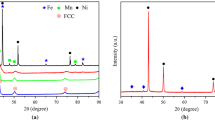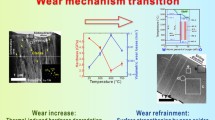Abstract
Fe2Ni2CrAl multi-principal elements alloy (MPEA) has been regarded as promising candidate for engineering application due to its desirable combination of strength and plasticity. In this work, the microstructure, hardness and wear resistance of Fe2Ni2CrAl MPEA were systematically investigated. This alloy has a dual-phase structure, comprised of the FCC and BCC/+B2 phase. The average nanohardness is 4.59 GPa, and the average elastic modulus is 199.4 GPa. By performing reciprocating ball-on-flat friction tests, the Fe2Ni2CrAl MPEA shows good wear resistance, with a wear rate of 8.72 × 10−5 mm3/(Nm) and average friction coefficient of ~ 0.54. The wear mechanisms are a mixture of adhesive, abrasive and oxidation wear, accompanied by cracks and delamination. Molecular dynamics (MD) was utilized to study the wear behavior at nanoscale. The surface suffers severer deformation during the first slide. Then, the reciprocating friction contributes to the surface strain hardening in the later slide. The large displacement and shear strain region were concentrated below the rigid ball, and the atomic damage was identified. Fewer dislocations are produced during reciprocating friction, accompanied with the reduced atomic shear strain and lattice deterioration. The Shockley-type dislocation plays a dominant role in the whole nano-wear process. This work explored the friction behavior in depth and provided a deep insight into wear mechanisms for Fe2Ni2CrAl MPEAs.














Similar content being viewed by others
Data availability
The data required to reproduce these findings cannot be shared at this time as the data also form part of an ongoing study.
References
Zhang Y, Yang X, Liaw PK (2012) Alloy design and properties optimization of high-entropy alloys. JOM 64:830–838
Yeh JW (2013) Alloy design strategies and future trends in high-entropy alloys. JOM 35(12):1759–1771
Yeh JW, Chen SK, Lin SJ, Gan JY, Chin TS, Shun TT, Tsau CH, Chang SY (2004) Nanostructured high-entropy alloys with multiprincipal elements-novel alloy design concepts and outcomes. Adv Eng Mater 6:299–303
Yong Z, Ting TZ, Zhi Tang MCG, Karin AD, Peter KL, Zhao PL (2014) Microstructures and properties of high-entropy alloys. Prog Mater Sci 61:1–93
Qiao L, Liu Y, Zhu J (2021) A focused review on machine learning aided high-throughput methods in high entropy alloy. J Alloy Compd 877:160295
Zhang W, Liaw PK, Zhang Y (2018) Science and technology in high-entropy alloys. Sci China Mater 61(1):2–22
Zhang L, Zhang Y (2020) Tensile properties and impact toughness of AlCoxCrFeNi3.1-x (x = 0.4, 1) high-entropy alloys. Front Mater 2:96
Li R, Ren Z, Yuan W, He Z, Liaw PK, Ren J, Zhang Y (2021) Mechanical behaviors and precipitation transformation of the lightweight high-Zn-content Al-Zn-Li-Mg-Cu alloy. Mater Sci Eng A 802:140637
Benbin X, Aijun Z, Jiesheng H, Junyan Z, Junhu M (2022) Enhancing mechanical properties of the boron doped Al0.2Co1.5CrFeNi1.5Ti0.5 high entropy alloy via tuning composition and microstructure. J Alloys Compd 896:162852
Lin D, Xi X, Li X, Jixu H, Lianyong X, Han Y, Zhang Y, Zhao L (2022) High-temperature mechanical properties of FeCoCrNi high-entropy alloys fabricated via selective laser melting. Mater Sci Eng A 832:142354
Wang J, Shangshu W, Shu F, Liu S, Yan M, Lai Q, Lan S, Hahn H, Feng T (2020) Ultrahigh hardness with exceptional thermal stability of a nanocrystalline CoCrFeNiMn high-entropy alloy prepared by inert gas condensation. Scripta Mater 187:335–339
Yang C, Ren C, Jia Y, Wang G, Li M, Wencong L (2022) A machine learning-based alloy design system to facilitate the rational design of high entropy alloys with enhanced hardness. Acta Mater 222:117431
Tao Yu, Wang H, Han K, Zhang B (2022) Microstructure and wear behavior of AlCrTiNbMo high-entropy alloy coating prepared by electron beam cladding on Ti600 substrate. Vacuum 199:110928
Dan K, Wei W, Taoran Z, Jing G (2022) Effect of superheating on microstructure and wear resistance of Al1.8CrCuFeNi2 high-entropy alloy. Mater Lett 311:131613
Bo W, Zhao Y, Ali H, Chen R, Chen H, Wen J, Liu Y, Liu L, Yang K, Zhang L, He Z, Yao Q, Zhang H, Sa B, Cuilian Wen Yu, Qiu HX, Maohua Lin Yu, Liu CW, Hang S (2022) A reasonable approach to describe the atom distributions and configurational entropy in high entropy alloys based on site preference. Intermetallics 144:107489
Qiao L, Aorigele ZL, Jingchuan Z (2020) A promising new class of multi-component alloys with exceptional mechanical properties. J Alloy Compd 847:155929
Qiao L, Ramanujan RV, Zhu J (2022) Effect of aluminum on the friction and wear behavior of Al x CrFeNi medium-entropy alloys. Adv Eng Mater 3:2101475
Jumaev E, Muhammad AA, Sang CM, Gian S, Soon-Jik H, Ki BK (2021) Nano-scale structural evolution of quaternary AlCrFeNi based high entropy alloys by the addition of specific minor elements and its effect on mechanical characteristics. J Alloy Compd 868:159217
Dong Y, Gao X, Yiping L, Wang T, Li T (2016) A multi-component AlCrFe2Ni2 alloy with excellent mechanical properties. Mater Lett 169:62–64
Liu X, Ding H, Huang Y, Bai X, Zhang Q, Zhang H, Langdon TG, Cui J (2021) Evidence for a phase transition in an AlCrFe2Ni2 high entropy alloy processed by high-pressure torsion. J Alloy Compd 867:159063
Jien-Min W, Lin S-J, Yeh J-W, Chen S-K, Huang Y-S, Chen H-C (2006) Adhesive wear behavior of AlxCoCrCuFeNi high-entropy alloys as a function of aluminum content. Wear 261(5–6):513–519
Ming-Hao C, Ming-Hung T, Woei-Ren W, Su-Jien L, Jien-Wei Y (2011) Microstructure and wear behavior of AlxCo1.5CrFeNi1.5Tiy high-entropy alloys. Acta Materialia 59(16):6308–6317
Xiao J-K, Tan H, Chen J, Martini A, Zhang C (2020) Effect of carbon content on microstructure, hardness and wear resistance of CoCrFeMnNiCx high-entropy alloys. J Alloy Compd 847:156533
Luo D, Zhou Q, Ye W, Ren Y, Greiner C, He Y, Wang H (2021) Design and characterization of self-lubricating refractory high entropy alloy-based multilayered films. ACS Appl Mater Interfaces 13(46):55712–55725
Li X, Zhang R, Liu Z, Yifan P (2022) Molecular dynamics study on friction of the iron-aluminum alloy. Mater Today Commun 33:104402
Yunqing T, Li DY (2021) Nano-tribological behavior of high-entropy alloys CrMnFeCoNi and CrFeCoNi under different conditions: a molecular dynamics study. Wear 476:203583
Qi Y, He T, Heming X, Yandong H, Wang M, Feng M (2021) Effects of microstructure and temperature on the mechanical properties of nanocrystalline CoCrFeMnNi high entropy alloy under nanoscratching using molecular dynamics simulation. J Alloy Compd 871:159516
Chen K-T, Wei T-J, Li G-C, Chen M-Y, Chen Y-S, Chang S-W, Yen H-W, Chen C-S (2021) Mechanical properties and deformation mechanisms in CoCrFeMnNi high entropy alloys: a molecular dynamics study. Mater Chem Phys 271:124912
Jia Q, He W, Hua D, Zhou Q, Yin D, Ren Y, Zhibin L, Wang H, Zhou F, Wang J (2022) Effects of structure relaxation and surface oxidation on nanoscopic wear behaviors of metallic glass. Acta Mater 232:117934
Zhou Q, Luo D, Hua D et al (2022) Design and characterization of metallic glass/graphene multilayer with excellent nanowear properties. Friction 10:1913–1926
Wang W, Hua D, Luo D, Zhou Q, Li S, Shi J, Wang H (2022) Molecular dynamics simulation of deformation mechanism of CoCrNi medium entropy alloy during nanoscratching. Comput Mater Sci 203:111085
Liu X, Hua D, Wang W, Zhou Q, Li S, Shi J, He Y, Wang H (2022) Atomistic understanding of incipient plasticity in BCC refractory high entropy alloys. J Alloy Compd 920:166058
Plimpton S (1995) Fast Parallel algorithms for short-range molecular dynamics. J Comput Phys 117:1–19
Farkas D, Caro A (2020) Model interatomic potentials for Fe-Ni-Cr-Co-Al high-entropy alloys. J Mater Res 35:3031–3040
Jones JE (1924) On the determination of molecular fields. I. From the equation of state of a gas. In: Proceedings of the Royal Society of London. Series A, Containing Papers of a Mathematical and Physical Character, vol 106, pp 463–477
Stukowski A (2009) Visualization and analysis of atomistic simulation data with OVITO-the open visualization tool model. Simulat Mater Sci Eng 2:18
Acknowledgements
This work is supported by AME Programmatic Fund by the Agency for Science, Technology and Research, Singapore under Grants No. A1898b0043 and A18B1b0061 and the China Scholarship Council.
Author information
Authors and Affiliations
Corresponding authors
Ethics declarations
Conflict of interest
The authors declare that they have no conflict of interest.
Ethical approval
Not Applicable.
Additional information
Handling Editor: Ghanshyam Pilania.
Publisher's Note
Springer Nature remains neutral with regard to jurisdictional claims in published maps and institutional affiliations.
Rights and permissions
Springer Nature or its licensor (e.g. a society or other partner) holds exclusive rights to this article under a publishing agreement with the author(s) or other rightsholder(s); author self-archiving of the accepted manuscript version of this article is solely governed by the terms of such publishing agreement and applicable law.
About this article
Cite this article
Qiao, L., Ramanujan, R.V. & Zhu, J. Uncovering wear mechanism of a Fe2Ni2CrAl multi-principal elements alloy. J Mater Sci 58, 2660–2675 (2023). https://doi.org/10.1007/s10853-023-08193-0
Received:
Accepted:
Published:
Issue Date:
DOI: https://doi.org/10.1007/s10853-023-08193-0




